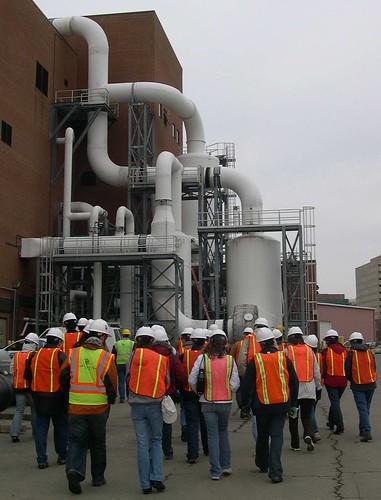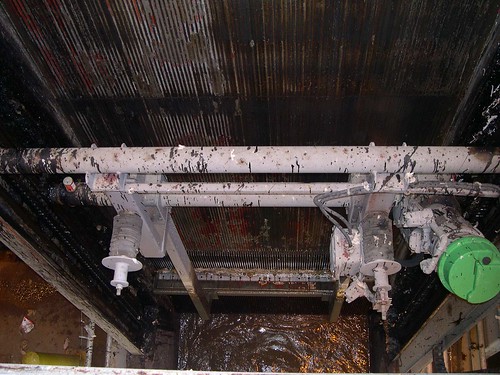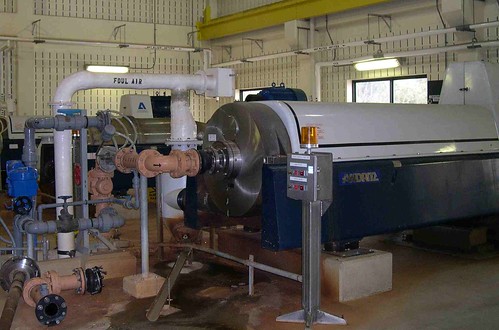
‘The merry band heads to the solids building’, courtesy of ‘mtngirl9999’
You might not think that many people would want to spend a Saturday morning in the sewer. At least I didn’t.
But when, in a fit of green curiosity, I tried to sign up for a tour of Arlington’s Water Pollution Control Plant last December, I was put on a waiting list. There were only 40 spots available on the tour, and 100 people–yes, 100 people–had already signed up.
So I snagged a coveted spot on the next tour, which also drew the interest of 100 wanna-be gawkers. (Another tour will take place this Saturday, or you can see a short video online.) I showed up even though the confirmation notice was a bit unnerving, saying, “Arrive adventure ready!” What adventures could happen in a place like that?
Wish you’d been there, too? Let’s satisfy your inquiring mind. This is what happens after you flush. Arlington’s system treats water that comes mainly through the drains, and sometimes from things like sump pumps. Rain or anything else that enters a storm drain pours directly into the nearest stream. This is not the case everywhere. For example, portions of the District have a combined sewer system. The short story: don’t swim downstream.
Peak flow to the Arlington plant occurs around 9:30 a.m. each day, except Sunday, when it’s an hour later.

‘Vertical bars – pulling out the big stuff’, courtesy of ‘mtngirl9999’
As wastewater comes in, about 30 million gallons a day, it flows through tall vertical bars to screen out the biggest solids. Watching this part is both fascinating and downright disgusting. To keep the bars clean, every minute or two a scraper disappears a story below into swirling waters and comes up bearing tissue paper, egg shells, and worse.

‘Phil Loar tells it like it is’, courtesy of ‘mtngirl9999’
“We’ve seen a lot of money, small dead rodents, once a severed hand,” said tour leader Phil Loar. “Sometimes people call and say, ‘I’ve lost a ring; can I come down and look for it?’” This debris gets hauled to the county’s trash incinerator in Alexandria, where it’s burned to produce energy. As such, Loar suggests Arlingtonians use the garbage disposal less if composting isn’t possible; throwing away food scraps sends them directly to the incinerator and is more energy efficient.
The water then runs into settling tanks, and what sifts to the bottom is treated separately as solids. The grease and scum that collect on top are skimmed off and sent to be burned.

‘Aeration tank – mmm’, courtesy of ‘mtngirl9999’
Next are the aeration tanks, which look like open vats of spraying brown water. (Did I mention this tour was an odd way to spend a Saturday morning?) These force oxygen into the water and create a feast for billions of microorganisms, which remove the nitrogen that otherwise would harm the Chesapeake Bay. The water then settles in clarifying pools, and ferric chloride is added to remove phosphorus.
The water sifts through beds of gravel, sand, and anthracite coal to filter out the remaining fine solids and phosphorus. Finally, it’s disinfected with chlorine bleach and neutralized, and presto! Out it pours into Four Mile Run, right by the bike path. No, you can’t drink it. (Would you want to?) It’s like water from a swimming pool.
That takes care of the water. The remaining solids are a different story.

‘Centrifuge – a special kind of spin cycle’, courtesy of ‘mtngirl9999’
They get mixed with polymer to make them sticky, put into a centrifuge that’s like a giant washing machine, and spun until they are drier, 23 to 28 percent solids. Lime is added to cut pathogens and that lovely smell, and they are dumped in trucks—about six truckloads and 100 wet tons a day.
Plant employees test them for health safety before sending them to certain farms within 100 miles or so of Arlington. The fertilizer can’t go on gardens because it may have heavy metals in it, but it can be used to grow pasture, corn or soybeans.
And that, oh curious folks, is the mystery behind the gates of Arlington’s wastewater treatment plant. And now, if anyone asks, you can say that yes, as a matter of fact you do know your…oh, never mind.
I was alternately fascinated and repulsed by all this… as I’m sure you were too! Also possibly the best title ever. Great job!
The comment on using the garbage disposal was really useful. Thanks for that. And, strangely enough, the tour sounds like fun!